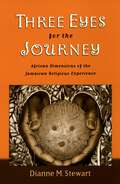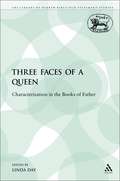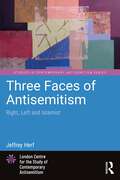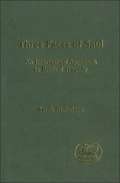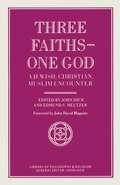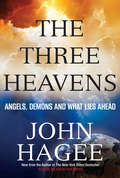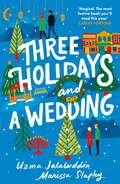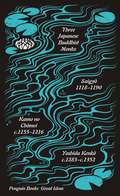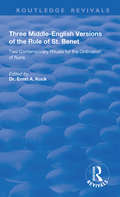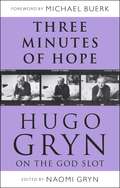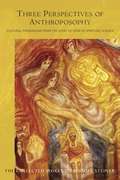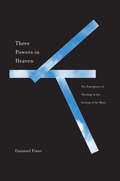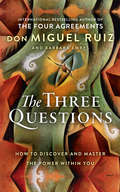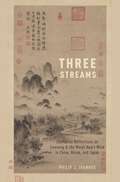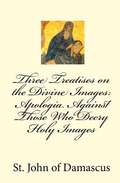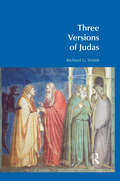- Table View
- List View
Three Eyes for the Journey: African Dimensions of the Jamaican Religious Experience
by Dianne M. StewartStudies of African-derived religious traditions have generally focused on their retention of African elements. This emphasis, says Dianne Stewart, slights the ways in which communities in the African diaspora have created and formed new religious meaning. In this fieldwork-based study Stewart shows that African people have been agents of their own religious, ritual, and theological formation. She examines the African-derived and African-centered traditions in historical and contemporary Jamaica: Myal, Obeah, Native Baptist, Revival/Zion, Kumina, and Rastafari, and draws on them to forge a new womanist liberation theology for the Caribbean.
Three Faces of a Queen: Characterization in the Books of Esther (The Library of Hebrew Bible/Old Testament Studies)
by Linda DayThis original study offers, for the first time, an analysis of the characterization of Esther as she is portrayed in each of the three primary versions of the book of Esther-the Masoretic text, the Septuagint text, and the Greek a text. This study of characterization has implications beyond itself. It permits a reasssessment of relations between the book of Esther and other literature of the time, it sheds light on the place of origin of the ancient versions of Esther, and it raises serious feminist and canon-critical questions about the role of the book.
Three Faces of Antisemitism: Right, Left and Islamist (Studies in Contemporary Antisemitism)
by Jeffrey HerfThree Faces of Antisemitism examines the three primary forms of antisemitism as they emerged in modern and contemporary Germany, and then in other countries.The chapters draw on the author’s historical scholarship over the years on the form antisemitism assumed on the far right in Weimar and Nazi Germany, in the Communist regime in East Germany, and in the West German radical left, and in Islamist organizations during World War II and the Holocaust, and afterward in the Middle East. The resurgence of antisemitism since the attacks of September 11, 2001, has origins in the ideas, events, and circumstances in Europe and the Middle East in the half century from the 1920s to the 1970s. This book covers the period since 1945 when neo-Nazism was on the fringes of Western and world politics, and the persistence of antisemitism took place primarily when its leftist and Islamist forms combined antisemitism with anti-Zionism in attacks on the state of Israel. The collection includes recent essays of commentary that draw attention to the simultaneous presence of antisemitism’s three faces. While scholarship on the antisemitism of the Nazi regime and the Holocaust remains crucial, the scholarly, intellectual, and political effort to fight antisemitism in our times requires the examination of antisemitism’s leftist and Islamist forms as well.This book will be of interest to scholars researching antisemitism, racism, conspiracy theories, the far right, the far left, and Islamism.
Three Faces of Antisemitism: Right, Left and Islamist (Studies in Contemporary Antisemitism)
by Jeffrey HerfThree Faces of Antisemitism examines the three primary forms of antisemitism as they emerged in modern and contemporary Germany, and then in other countries.The chapters draw on the author’s historical scholarship over the years on the form antisemitism assumed on the far right in Weimar and Nazi Germany, in the Communist regime in East Germany, and in the West German radical left, and in Islamist organizations during World War II and the Holocaust, and afterward in the Middle East. The resurgence of antisemitism since the attacks of September 11, 2001, has origins in the ideas, events, and circumstances in Europe and the Middle East in the half century from the 1920s to the 1970s. This book covers the period since 1945 when neo-Nazism was on the fringes of Western and world politics, and the persistence of antisemitism took place primarily when its leftist and Islamist forms combined antisemitism with anti-Zionism in attacks on the state of Israel. The collection includes recent essays of commentary that draw attention to the simultaneous presence of antisemitism’s three faces. While scholarship on the antisemitism of the Nazi regime and the Holocaust remains crucial, the scholarly, intellectual, and political effort to fight antisemitism in our times requires the examination of antisemitism’s leftist and Islamist forms as well.This book will be of interest to scholars researching antisemitism, racism, conspiracy theories, the far right, the far left, and Islamism.
Three Faces of Saul: An Intertextual Approach to Biblical Tragedy (The Library of Hebrew Bible/Old Testament Studies)
by Sarah NicholsonA fascinating intertextual study of the classic biblical tragedy of Saul, the first king of Israel, as first narrated in biblical narrative and later reworked in Lamartine's drama Saul: Tragédie and Thomas Hardy's novel The Mayor of Casterbridge. Plot and characterization are each explored in detail in this study, and in each of the narrations the hero's tragic fate emerges both as the result of a character flaw and also as a consequence of the ambivalent role of the deity, showing a double theme underlying not only the biblical vision but also its two very different retellings nearer to our own times.
Three Faiths — One God: A Jewish, Christian, Muslim Encounter (Library of Philosophy and Religion)
by MeltzerdThe interactions of the Jewish, Christian and Muslim communities through the centuries have often been hostile and sometimes violent. Today a new 'trialogue' between them is developing in several parts of the world. One of the most ambitious ventures so far of this kind took place recently in California and produced this set of exploratory papers and responses. The subjects are the concepts of God in the three traditions, their attitudes to the material world, and their understandings of human life and history. The discussions were frank and realistic but at the same time hopeful.
The Three Heavens: Angels, Demons and What Lies Ahead
by John HageeAs sales of Hagee's current New York Times bestseller, Four Blood Moons, continue to soar, hundreds of thousands of readers have had their thirst whetted to know what is to come at the end of this world . . . heaven itself! Hagee's national media power assures another mega-bestseller.
Three Holidays and a Wedding: A cosy, festive holiday rom com, perfect for fans of Ayesha at Last and The Matzah Ball
by Uzma Jalaluddin Marissa Stapley'The quintessential holiday rom-com...Three Holidays and a Wedding combines two budding romances, a massive snowstorm, unlikely friends, meddling family members, and one magical small town for the most festive book you'll read this year' CARLEY FORTUNEThree times the holiday magic. Three times the chaos.As strangers and seatmates Maryam Aziz and Anna Gibson fly to Toronto over the holidays - Maryam to her sister's impromptu wedding, and Anna to meet her boyfriend's wealthy family for the first time - neither expect that severe turbulence will scare them into confessing their deepest hopes and fears to one another. At least they'll never see each other again. Unfortunately, Maryam's lifelong crush Saif happened to be sitting two rows behind them and heard it all - including her professing undying love for him. Oops.When the flight is diverted, Anna, Maryam, Saif and the bridal party find themselves snowbound at an inn in the remote, quirky town of Snow Falls - where a holiday romance starring Anna's celebrity crush is being filmed - and chaos ensues. But as Maryam and Anna start to give into the magic of Snow Falls, they might just realise there's no place they'd rather be for the holidays.Praise for Three Holidays and a Wedding:'The perfect cozy read that turns winter travel chaos into holiday magic!' Amy E. Reichert, author of Once Upon a December'From its very first pages, Three Holidays and a Wedding whisked me away and dropped me down, gently, into a festive fairytale. This sweet, sparkling novel is as fun and surprising as a perfect snow day.' Lauren Fox, author of Send for Me'A heartwarming celebration of love, family and faith' Jean Meltzer, author of The Matzah Ball'Festive and fun! A one-of-a-kind swoony story that celebrates so much more than just Christmas!' Chantel Guertin, author of Instamom
Three Japanese Buddhist Monks (Penguin Great Ideas)
by Saigyo Kamo no Chomei Yoshida Kenko'I have relinquished all that ties me to the world, but the one thing that still haunts me is the beauty of the sky'These simple, inspiring writings by three medieval Buddhist monks offer peace and wisdom amid the world's uncertainties, and are an invitation to relinquish earthly desires and instead taste life in the moment.One of twenty new books in the bestselling Penguin Great Ideas series. This new selection showcases a diverse list of thinkers who have helped shape our world today, from anarchists to stoics, feminists to prophets, satirists to Zen Buddhists.
Three kings and star (Large print)
by RnibThis page shows the three kings (magi or wise men) following the Star of Bethlehem through the night on camels to witness the birth of Jesus. There is a locator dot shown, which will be at the top left of the page when the image is the correct way up. A dashed line image border surrounds the image. The kings are seen from the side facing to the left. Each one is seen from the side riding on their camel. They are following the Star of Bethlehem, which can be found in the top left of the image with a ring of light rays surrounding it.
Three kings and star (UEB Contracted)
by RnibThis page shows the three kings (magi or wise men) following the Star of Bethlehem through the night on camels to witness the birth of Jesus. There is a locator dot shown, which will be at the top left of the page when the image is the correct way up. A dashed line image border surrounds the image. The kings are seen from the side facing to the left. Each one is seen from the side riding on their camel. They are following the Star of Bethlehem, which can be found in the top left of the image with a ring of light rays surrounding it.
Three kings and star (UEB Uncontracted)
by RnibThis page shows the three kings (magi or wise men) following the Star of Bethlehem through the night on camels to witness the birth of Jesus. There is a locator dot shown, which will be at the top left of the page when the image is the correct way up. A dashed line image border surrounds the image. The kings are seen from the side facing to the left. Each one is seen from the side riding on their camel. They are following the Star of Bethlehem, which can be found in the top left of the image with a ring of light rays surrounding it.
Three Middle-English Versions of the Rule of St. Benet: Two Contemporary Rituals for the Ordination of Nuns (Routledge Revivals)
by Ernst A. KockFirst published in 1902, this volume contains an extensive, technical scholarly introduction, followed by three Middle-English versions of the Rule of St. Benet along with the Northern Lansdowne Ritual on the reception of novices and the Vespasian Ritual of making a nun. As St Benet is the Medieval English version of St. Benedict, the original version of this text dates back to the 6th century.
Three Middle-English Versions of the Rule of St. Benet: Two Contemporary Rituals for the Ordination of Nuns (Routledge Revivals)
by Ernst A. KockFirst published in 1902, this volume contains an extensive, technical scholarly introduction, followed by three Middle-English versions of the Rule of St. Benet along with the Northern Lansdowne Ritual on the reception of novices and the Vespasian Ritual of making a nun. As St Benet is the Medieval English version of St. Benedict, the original version of this text dates back to the 6th century.
Three Minutes of Hope: Hugo Gryn On The God Slot
by Hugo Gryn Naomi GrynA collection of Hugo Gryn's scripts for radio 'God slots', bringing the wisdom and humanity of one of Britain's best-loved spiritual leaders to a new generation.
Three Minutes of Hope: Hugo Gryn on The God Slot
by Hugo GrynA collection of Hugo Gryn's scripts for radio 'God slots', bringing the wisdom and humanity of one of Britain's best-loved spiritual leaders to a new generation.
Three Perspectives of Anthroposophy: Cultural Phenomena from the Point of View of Spiritual Science
by Rudolf SteinerWhat is truly real? Rudolf Steiner sheds light on everyday reality through spiritual knowledge, repeatedly urging us to bring anthroposophy into daily human existence. We might consciously experience the difference between consuming a potato as compared to cereals such as rye, for example – or we could grasp ordinary phenomena, such as sleepwalking, through an understanding of the threefold human being. Likewise, we might strive to comprehend how our head is the transformed organism of our previous life. Throughout, Steiner emphasizes that we can achieve spirituality on earth if only we make anthroposophy real.The twelve lectures here were delivered during the portentous year of 1923, in the context of increasing attacks from Steiner’s opponents. His architectural masterpiece, the first Goetheanum, had already been destroyed by fire, but he was yet to refound the Anthroposophical Society at the Christmas Conference. In these uncertain times, Steiner speaks of the decline of European culture and the development of materialism as a philosophy, leaving anthroposophy with no exoteric foundation on which to build. But Rudolf Steiner strikes a positive note with an exciting and constructive way forward, providing us with the tools to see the world through three key perspectives of anthroposophy: the physical, the soul and the spiritual dimensions of reality.This previously-unpublished volume is translated by Elizabeth Marshall and includes an introduction, notes and index.
Three Powers in Heaven: The Emergence of Theology and the Parting of the Ways (Synkrisis)
by Emanuel FianoA fresh look at how Christianity and Judaism became two distinct religions through the parting of their intellectual traditions How, when, and why did Christianity and Judaism diverge into separate religions? Emanuel Fiano reinterprets the parting of the ways between Jews and Christians as a split between two intellectual traditions, a split that emerged within the context of ancient debates about Jesus’s relationship to God and the world. Fiano explores how Christianity moved away from Judaism through the development of new practices for religious inquiry. By demonstrating that the constitution of communal borders coincided with the elaboration of different methods for producing religious knowledge, the author shows that Christian theological controversies, often thought to teach us nothing beyond the history of dogma, can cast light on the broader religious landscape of late antiquity. Three Powers in Heaven thus marks not only a historical but also a methodological intervention in the study of the parting of the ways and in scholarship on ancient religion.
The Three Questions: How To Discover And Master The Power Within You
by Don Miguel Ruiz Barbara EmrysFrom the author of the international bestseller The Four Agreements comes a profound guide which grounds itself further in the tradition of Toltec wisdom, helping us find and use the hidden power within us to achieve our fullest and most authentic lives.
Three Streams: Confucian Reflections on Learning and the Moral Heart-Mind in China, Korea, and Japan
by Philip J. IvanhoeRecent interest in Confucianism has a tendency to suffer from essentialism and idealism, manifested in a variety of ways. One example is to think of Confucianism in terms of the views attributed to one representative of the tradition, such as Kongzi (Confucius) (551-479 BCE) or Mengzi (Mencius) (372 - 289 BCE) or one school or strand of the tradition, most often the strand or tradition associated with Mengzi or, in the later tradition, that formed around the commentaries and interpretation of Zhu Xi (1130-1200). Another such tendency is to think of Confucianism in terms of its manifestations in only one country; this is almost always China for the obvious reasons that China is one of the most powerful and influential states in the world today. A third tendency is to present Confucianism in terms of only one period or moment in the tradition; for example, among ethical and political philosophers, pre-Qin Confucianism--usually taken to be the writings attributed to Kongzi, Mengzi, and, if we are lucky, Xunzi (479-221 BCE)--often is taken as "Confucianism." These and other forms of essentialism and idealism have led to a widespread and deeply entrenched impression that Confucianism is thoroughly homogenous and monolithic (these often are "facts" mustered to support the purportedly oppressive, authoritarian, and constricted nature of the tradition); such impressions can be found throughout East Asia and dominate in the West. This is quite deplorable for it gives us no genuine sense of the creatively rich, philosophically powerful, highly variegated, and still very much open-ended nature of the Confucian tradition. This volume addresses this misconstrual and misrepresentation of Confucianism by presenting a philosophically critical account of different Confucian thinkers and schools, across place (China, Korea, and Japan) and time (the 10th to 19th centuries).
Three Streams: Confucian Reflections on Learning and the Moral Heart-Mind in China, Korea, and Japan
by Philip J. IvanhoeRecent interest in Confucianism has a tendency to suffer from essentialism and idealism, manifested in a variety of ways. One example is to think of Confucianism in terms of the views attributed to one representative of the tradition, such as Kongzi (Confucius) (551-479 BCE) or Mengzi (Mencius) (372 - 289 BCE) or one school or strand of the tradition, most often the strand or tradition associated with Mengzi or, in the later tradition, that formed around the commentaries and interpretation of Zhu Xi (1130-1200). Another such tendency is to think of Confucianism in terms of its manifestations in only one country; this is almost always China for the obvious reasons that China is one of the most powerful and influential states in the world today. A third tendency is to present Confucianism in terms of only one period or moment in the tradition; for example, among ethical and political philosophers, pre-Qin Confucianism--usually taken to be the writings attributed to Kongzi, Mengzi, and, if we are lucky, Xunzi (479-221 BCE)--often is taken as "Confucianism." These and other forms of essentialism and idealism have led to a widespread and deeply entrenched impression that Confucianism is thoroughly homogenous and monolithic (these often are "facts" mustered to support the purportedly oppressive, authoritarian, and constricted nature of the tradition); such impressions can be found throughout East Asia and dominate in the West. This is quite deplorable for it gives us no genuine sense of the creatively rich, philosophically powerful, highly variegated, and still very much open-ended nature of the Confucian tradition. This volume addresses this misconstrual and misrepresentation of Confucianism by presenting a philosophically critical account of different Confucian thinkers and schools, across place (China, Korea, and Japan) and time (the 10th to 19th centuries).
The Three Temples: On the Emergence of Jewish Mysticism (The Littman Library of Jewish Civilization)
by Rachel EliorIn this ground-breaking study, Rachel Elior offers a comprehensive theory of the crystallization of the early stages of the mystical tradition in Judaism based on the numerous ancient scrolls and manuscripts published in the last few decades. Her wide-ranging research, scrupulously documented, enables her to demonstrate an uninterrupted line linking the priestly traditions of the Temple, the mystical liturgical literature found in the Qumran caves and associated directly and indirectly with the Merkavah tradition of around the second and first centuries BCE, and the mystical works of the second to fifth centuries CE known as Heikhalot literature. The key factor linking all these texts, according to Professor Elior’s theory, is that many of those who wrote them were members of the priestly classes. Prevented from being able to perform the rituals of sacred service in the Temple as ordained in the biblical tradition, they channelled their religious impetus in other directions to create a new spiritual focus. The mystical tradition they developed centred first on a heavenly Chariot Throne known as the Merkavah, and later on heavenly sanctuaries known as Heikhalot. In this way the priestly class developed an alternative focus for spirituality, based on a supertemporal liturgical and ritual relationship with ministering angels in the supernal sanctuaries. This came to embrace an entire mystical world devoted to sustaining religious liturgical tradition and ritual memory in the absence of the Temple. This lyrical investigation of the origins and workings of this supernal world is sure to become a standard work in the study of early Jewish mysticism.
Three Treatises on the Divine Images: Apologia Against Those Who Decry Holy Images
by St. John of DamascusSaint John of Damascus(c. 676 - 4 December 749) was an Arab Christian monk and priest. Born and raised in Damascus, he died at his monastery, Mar Saba, near Jerusalem. <p><p> A polymath whose fields of interest and contribution included law, theology, philosophy, and music, before being ordained, he served as a Chief Administrator to the Muslim caliph of Damascus, wrote works expounding the Christian faith, and composed hymns which are still in everyday use in Eastern Christian monasteries throughout the world. <p> In the early 8th century AD, iconoclasm, a movement seeking to prohibit the veneration of the icons, gained some acceptance in the Byzantine court. In 726, despite the protests of St. Germanus, Patriarch of Constantinople, Emperor Leo III issued his first edict against the veneration of images and their exhibition in public places. A talented writer in the secure surroundings of the caliph's court, John of Damascus initiated a defense of holy images in three separate publications. <p> "Apologetic Treatises against those Decrying the Holy Images", the earliest of these works gained him a reputation. Not only did he attack the emperor, but the use of a simpler literary style brought the controversy to the common people, inciting revolt among those of Christian faith. His writings later played an important role during the Second Council of Nicaea which met to settle the icon dispute.
Three Versions of Judas (BibleWorld)
by Richard G. WalshJudas Iscariot, known for his betrayal of Jesus, is a key figure in the Gospel narratives. As an insider become outsider, Judas demarcates Christian boundaries of good and evil. 'Three Versions of Judas' examines the role of Judas in Christian myth-making. The book draws on Jorge Luis Borges' "Three Versions of Judas" to present three Judases in the Gospels: a Judas necessary to the divine plan; a Judas who is a determined outsider, denying himself for God's glory; and a Judas who is demonic. Exploring the findings of biblical criticism and artistic responses to Judas, 'Three Versions of Judas' offers an analysis of the evil necessarily inherent in Christian narratives about Judas.
Three Versions of Judas (BibleWorld)
by Richard G. WalshJudas Iscariot, known for his betrayal of Jesus, is a key figure in the Gospel narratives. As an insider become outsider, Judas demarcates Christian boundaries of good and evil. 'Three Versions of Judas' examines the role of Judas in Christian myth-making. The book draws on Jorge Luis Borges' "Three Versions of Judas" to present three Judases in the Gospels: a Judas necessary to the divine plan; a Judas who is a determined outsider, denying himself for God's glory; and a Judas who is demonic. Exploring the findings of biblical criticism and artistic responses to Judas, 'Three Versions of Judas' offers an analysis of the evil necessarily inherent in Christian narratives about Judas.
